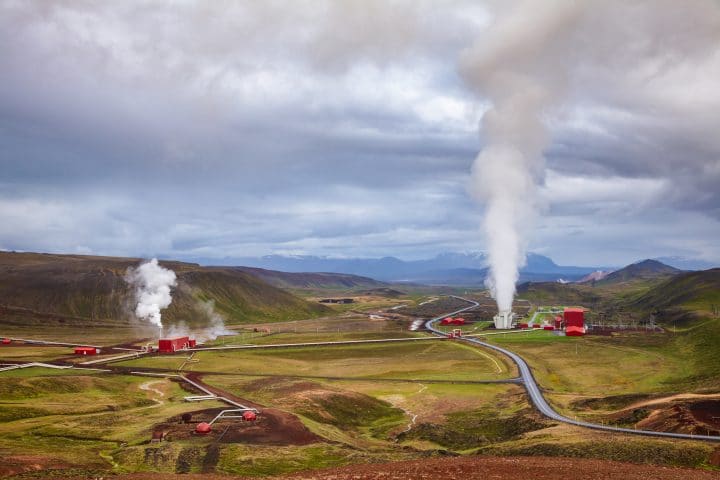The use of geothermal energy can have wide-ranging impacts on the local environment. This can include everything from water contamination through to the emission of harmful gases. In this article, we explore the environmental impacts of geothermal energy.
How Geothermal Energy Can Affect The Environment
Geothermal energy can affect the environment in lots of different ways. Below, you will learn how all of these effects relate to geothermal power. They are not relevant in the case of domestic geothermal heating systems.
Domestic geothermal installations are relatively low-impact where the environment is concerned. They do not make use of geothermal fluids from deep within the earth. Instead, such systems only tap into the heat of the ground up to a few meters beneath our feet.
The following are all examples of how geothermal power can affect the environment.
Water Contamination
Geothermal power plants can cause water quality and contamination problems. Underground geothermal reservoirs often contain high concentrations of harmful substances. These can include sulfur, salts and other compounds and minerals.
In open-loop geothermal power plants, these substances can seep out into the local environment. This then has the potential to affect the quality of the local water table.
Water quality is less of a concern in closed-loop systems. Here, as the term suggests, the water is closed off and contained within the system. Such power plants will then often reinject the fluids back where they came from.
Water Consumption
Water consumption is another example of how geothermal energy can affect the environment. Geothermal power plants consume water in two distinct ways:
- For Cooling Purposes – This process mostly uses spent geothermal fluids but sometimes uses local supplies of freshwater.
- For Replenishing Geothermal Reservoirs – Open-loop systems need to replenish the water inside their underground reservoirs to ensure an ongoing supply. Closed-loop systems also need to do this as some of the geothermal fluids are lost as steam.
Tower cooled geothermal plants can consume up to 5,147 gallons of water per megawatt-hour (MWh). This is according to a report by the National Renewable Energy Laboratory. The same report shows how geothermal has the second highest water consumption of all renewable and non-renewable power plants. It is only beaten by hydropower (for obvious reasons).
Air Pollution
Geothermal energy can also cause air pollution and local air quality issues. Extracting geothermal fluids releases gases that are harmful to both the environment and our health. Some of these gases include:
- Hydrogen Sulfide (H2S) – The most abundant gas a geothermal power plant can release.
- Carbon Dioxide (CO2) – One of the key greenhouse gases contributing to climate change.
- Ammonia (NH3) – A compound of nitrogen and hydrogen that can cause serious health issues and/or death in high concentrations.
- Methane (CH4) – Another powerful greenhouse gas contributing to climate change.
This is more prevalent in open-loop systems where gases are not contained. Closed-loop systems tend to be less affected. Air pollution is one of the main disadvantages of geothermal energy.
Land Use
Land use is another environmental impact of geothermal energy. Although geothermal power stations are often much smaller than fossil fuel alternatives, they still take up space. This does depend on the type and size of the plant but will often leave a mark on the environment.

Subsidence
Most designs of geothermal power plants extract superheated fluids from deep beneath the earth’s surface. If these are not replenished, then an empty pocket is left. Over time, the land above this pocket may subside to fill the space. This can cause subsidence at ground level, affecting both man-made structures and the environment.
The extraction of geothermal fluids has also been linked to seismic instability. This is, however, more of a safety issue than an environmental concern.
Hazardous Waste
Some geothermal installations make use of filtration systems to capture their emissions. Whilst this is a positive step in helping to reduce the level of harmful emissions being released into the environment, they don’t just disappear.
Filtration systems capture harmful substances, forming a toxic sludge. We can’t just throw this away in any old manner. Instead, it should be sent to a hazardous waste facility for reprocessing and/or safe disposal.
Noise Pollution
Last in our list is the noise pollution geothermal energy can create. Although geothermal power plants are fairly quiet, they still emit noise from cooling systems and other components. For those living close to such facilities, this can become an issue.
Fortunately, most geothermal power plants are far enough away from populated areas for this to cause problems. Wind turbines tend to be a greater concern for residents where noise pollution is concerned.
So, Is Geothermal Energy Bad For The Environment?
There are significant concerns surrounding the environmental impact of geothermal energy. Having said this, there are other aspects you should take into account.
Geothermal energy has lots of positive effects on the environment. For instance, by using it to generate power, we reduce the level of fossil fuels we burn. This has wide-ranging benefits, not just on the environment but also on our health.
Reducing the level of fossil fuels we burn also reduces overall emissions of greenhouse gases. Whilst geothermal power plants can release such gases, they emit far less per kWh than fossil fuels. As an example, geothermal power has lifecycle emissions of around 95% less than coal. This factor alone outweighs the environmental impacts of geothermal energy.
We can conclude that geothermal energy is good for the environment. It may not be the cleanest renewable energy source but it’s still far better than fossil fuel alternatives.